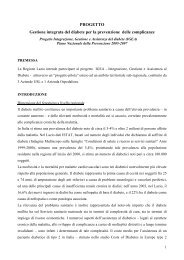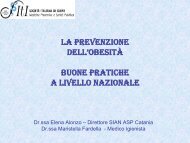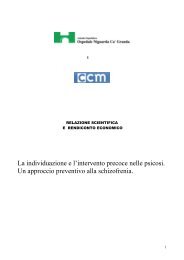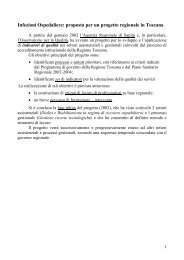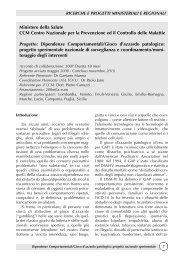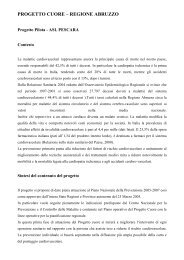Gaining health : analysis of policy development in European ...
Gaining health : analysis of policy development in European ...
Gaining health : analysis of policy development in European ...
Create successful ePaper yourself
Turn your PDF publications into a flip-book with our unique Google optimized e-Paper software.
More recently, however, the school sett<strong>in</strong>g does not appear<br />
to have been utilized as well as might be expected. With<br />
the devolution <strong>of</strong> greater responsibility to the municipalities,<br />
<strong>in</strong>clud<strong>in</strong>g decisions on <strong>health</strong> education <strong>in</strong> schools, considerable<br />
disparities have evolved at the local level and school<br />
<strong>health</strong> education has become disjo<strong>in</strong>ted and unorganized.<br />
Apparently only a very small proportion <strong>of</strong> schools now<br />
meet the national standards for <strong>health</strong> education.<br />
Teenage pregnancies and abortions are among the lowest<br />
<strong>in</strong> the world, but smok<strong>in</strong>g figures among teenagers are<br />
comparatively high. Despite the fact that obesity <strong>in</strong> children<br />
is <strong>in</strong>creas<strong>in</strong>g, physical education is no longer compulsory <strong>in</strong><br />
schools.<br />
2.6.3. Healthy Cities<br />
A number <strong>of</strong> F<strong>in</strong>nish cities jo<strong>in</strong>ed the WHO Healthy Cities<br />
programme from an early stage, and the F<strong>in</strong>nish National<br />
Healthy Cities Network was founded <strong>in</strong> 1996 with the aim<br />
<strong>of</strong> assist<strong>in</strong>g <strong>in</strong> the implementation <strong>of</strong> the national Health for<br />
All <strong>policy</strong>. STAKES acts as the coord<strong>in</strong>ator and gives secretarial<br />
support to the Network. STAKES <strong>of</strong>fers <strong>development</strong>al<br />
support and is <strong>in</strong>strumental <strong>in</strong> dissem<strong>in</strong>at<strong>in</strong>g <strong>in</strong>formation<br />
to municipalities throughout the country, thus broaden<strong>in</strong>g<br />
the impact <strong>of</strong> the Network. Priority areas for 2005–2008<br />
<strong>in</strong>clude:<br />
• reduc<strong>in</strong>g <strong>in</strong>equalities <strong>in</strong> <strong>health</strong>;<br />
• formulat<strong>in</strong>g municipal welfare reports;<br />
• recommendations concern<strong>in</strong>g the <strong>health</strong> promotion<br />
aspect <strong>of</strong> human impact assessment;<br />
• <strong>health</strong>y urban plann<strong>in</strong>g;<br />
• <strong>health</strong>y age<strong>in</strong>g; and<br />
• physical activity.<br />
2.7. Policies for specific population groups – older<br />
people<br />
The 1985 Health for All <strong>policy</strong> considered population age<strong>in</strong>g<br />
the most important demographic factor affect<strong>in</strong>g <strong>health</strong><br />
<strong>policy</strong>, and tackl<strong>in</strong>g chronic illness and disability <strong>in</strong> the elderly<br />
one <strong>of</strong> the ma<strong>in</strong> challenges to public <strong>health</strong>. Some 80% <strong>of</strong><br />
beds <strong>in</strong> PHC centres were then be<strong>in</strong>g used for the care <strong>of</strong><br />
older people, <strong>in</strong> less than optimal circumstances. Although<br />
the importance <strong>of</strong> community care was mentioned, and<br />
about 90% <strong>of</strong> communes already employed home helps to<br />
support older people, the ma<strong>in</strong> proposals <strong>in</strong> the Health for<br />
All <strong>policy</strong> related to <strong>health</strong> care.<br />
F<strong>in</strong>land developed its first National Age<strong>in</strong>g Policy <strong>in</strong> 1996.<br />
Its ma<strong>in</strong> recommendations referred to: ma<strong>in</strong>ta<strong>in</strong><strong>in</strong>g the<br />
<strong>health</strong> and work<strong>in</strong>g ability <strong>of</strong> older people; ma<strong>in</strong>ta<strong>in</strong><strong>in</strong>g a<br />
good standard <strong>of</strong> liv<strong>in</strong>g and hous<strong>in</strong>g; develop<strong>in</strong>g a needsled<br />
service supply system; improv<strong>in</strong>g care; and creat<strong>in</strong>g an<br />
enabl<strong>in</strong>g society whereby older people have similar rights to<br />
participate and live their lives as others.<br />
The ma<strong>in</strong> aim <strong>of</strong> the <strong>policy</strong> was to enhance the autonomy<br />
<strong>of</strong> older people and help them manage their lives <strong>in</strong>dependently.<br />
It was expected to be achieved through better<br />
coord<strong>in</strong>ation <strong>of</strong> the public and private sectors, NGOs and<br />
households themselves. It appears, however, that dur<strong>in</strong>g<br />
difficult economic times the community care system has<br />
not been developed as quickly as <strong>in</strong>tended and services for<br />
older people are vulnerable to cuts at the municipal level.<br />
The Government is expected to present a report on national<br />
age<strong>in</strong>g <strong>policy</strong> to Parliament every four years. Although<br />
it is not clear how far morbidity and frailty can be compressed<br />
<strong>in</strong> the later years <strong>of</strong> life, on the whole the <strong>health</strong><br />
<strong>of</strong> older people has improved. They have fewer symptoms,<br />
chronic conditions and circulatory diseases than 20 years<br />
ago (30).<br />
Pensioners have been organiz<strong>in</strong>g themselves s<strong>in</strong>ce the 1950s<br />
and now have strong NGOs, although, as <strong>in</strong> most countries,<br />
the jo<strong>in</strong>ers are the better educated while a large group <strong>of</strong><br />
non-jo<strong>in</strong>ers rema<strong>in</strong>s out <strong>of</strong> the participation picture (11).<br />
Chapter 4<br />
59<br />
Case studies: <strong>policy</strong> <strong>development</strong> <strong>in</strong> countries for tackl<strong>in</strong>g noncommunicable diseases




